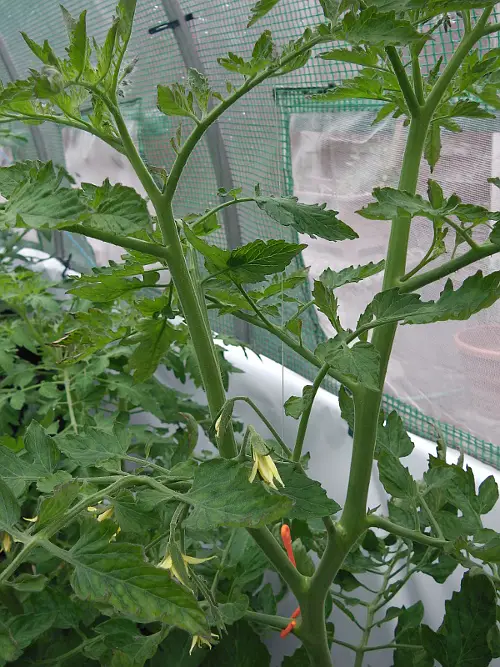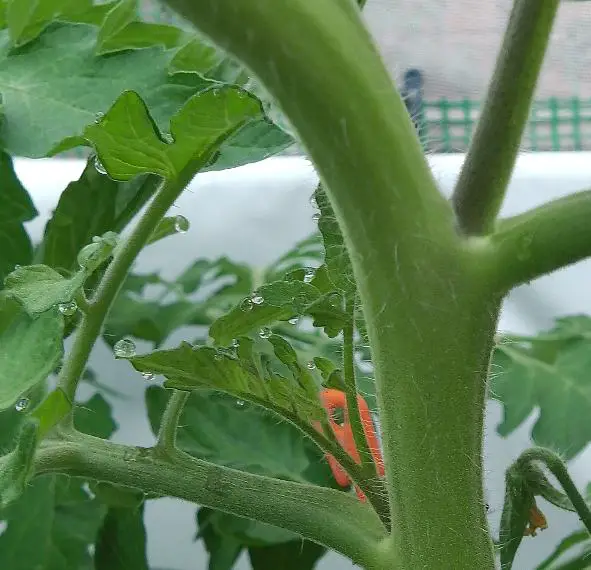Double Stems and Side Shoots
Some professional growers allow a side shoot to develop and become a second main stem. This has the following advantages:
- More trusses
- Trusses at a lower height than if grown on one stem
- Plants are easier to prune and manage generally – unless you have a tall greenhouse and step ladder!

It’s best to use this technique with cherry varieties that are quick to mature if you are in a short season area such as the UK.
Larger varieties require more energy for growth – so increasing the number of trusses of large tomatoes grown using two stems, needs a very good Summer and is more challenging.
This side shoot could be left to grow and create a second stem if required … otherwise, it’s best removed. Side shoots are normally removed from tall varieties to keep one main stem.

Guttation
You may notice the drops of water on the edges of the leaves in the photo above. This is called “guttation”.
When leaf stomata close at night and there is a build up of pressure in the plant, moisture is forced out of the leaf edges through pores called hydathodes. These are water glands that live near the vein endings in the tips of leaves.
Guttation is usually seen first thing in the morning after a night when stomata have been closed and it’s most likely to occur in the greenhouse in warm weather.
We’re Having a Heatwave
It looks as if we have a mini heatwave on the way – in the UK.
Although tomato plants like warm sunny weather, many of the varieties we grow in the UK don’t do well in higher temperatures and become stressed.
The general rule of thumb is – if it’s too hot to sit in the sun for us humans, it’s probably too hot in the sun for a tomato plant!
Here are a few tips for helping your tomato plants to cope:
Watering
Most container grown plants, especially those in hanging baskets, may need watering twice a day.
Keep your eye on plants watered in trays by the Smart Valve or by capillary action such as the Quadgrow Planter – some manual watering may be necessary.
Air Flow
It’s best to keep windows open in the greenhouse to avoid temperatures and humidity becoming too high.
Shading
Cool glass (similar to the old windowlene) can be used on windows to help shade plants. One or two sheets of garden fleece http://can also help to diffuse direct sunlight.
When Growth Stops
If temperatures in the greenhouse reach around 35C, sugar production in the leaves (photosynthesis) levels off, but plants continue to need more sugar for growth as temperatures rise. This can result in growth stopping and fruit losing its sweetness!
Feeding In Hot Weather
If using mineral feeds like Tomorite or Chempak, it’s best to reduce the strength of food given when the weather is hot.
Plants use a lot of water which usually evaporates through the leaf pores (stomata). However, the minerals remain in their system – reducing the amount of water that they can hold.
Also, the stronger the solution around the roots, the slower a plant is able to absorb water. So, on a hot day plants may wilt if overfed.
Feeding Generally
The best way to feed under normal conditions is to give half the amount recommended on the pack at every watering or every other watering – depending on the stage of growth.
However, being too generous may produce fruit that ripen before they reach full size, wilting in hot weather and Blossom End Rot – to name just a few problems.
If you are new to growing tomatoes this season, please don’t be put off by the possibility of so many problems and suggested tweaks. Chances are you’ll get a good crop by following the directions on the side of the pack!
This article “Double Stems and Side Shoots” was originally one of Nick’s Tomato Growing Newsletters.


Steve Hoyle
I’m growing 100s and 1000s for the first time at school, these have been grown by our students from seed and are very healthy plants . Do I leave all the side shoots and grow as a bush or do I take some of them off. On the tall variety tomatoes I always remove the side shoots.
Nick
Hi Steve, you can leave the side shoots on 100s and 1000s and grow as a bush – it’s a great trailing variety!
Buster
Tomato wine seems an interesting adventure Nick. Would it still have a Lycopene content? Very healthy we are told.
Nick
You bet, but I’m using it as an excuse … it’s the Lycopene that produces the blood-shot eyes the next morning!!!
Ethel Craig
Hi Nick,
Thanks for that reply. I will remove the large head in the morning. There is still a bit of growth coming on behind so hopefully this will encourage further truss development.
Buster
Thanks Nick for your tomato growing site. Good balance between science & growing for pleasure & eating.
Nick
Thanks Buster – I think I may add drinking to your list with a recipe for tomato wine!
Eva Davison
Hi Nick, I have found your tips really helpful. I have tried to grow tomatoes for years without much success so fingers crossed I may get it right this year.
Nick
Hi Eva, I’m pleased that you find the tips helpful and I hope you have a great season!
Ethel Craig
I have a query related to the above item. Although we are very far behind this year in Scotland due to the poor weather I have my usual seed sown selection finally coming along in the greenhouse. For quite a few years I have successfully grown the variety Costoluto. This year as several times in the past the first truss has formed together with an extra large flower head which seems to result in the cessation of any further growth. I would be interested to hear any comments on this problem.
Nick
Hi Ethel, It’s best to remove this large flower, sometimes called a King flower, because it will take energy away from the growth of the rest of the truss.
Some growers who want to produce larger tomatoes will take the seeds from the fruit of the King flower which will produce larger toms than usual.
Mark
Personally, I like to grow the megablooms as I find that the tomato grown usually contains more flesh and fewer seeds. I’ve never noticed them stopping further growth on the plant.
The only counter to that is that (once) the megabloom grew in the centre of the plant and the plant didn’t develop a a growing point, nor did it develop any sideshoots.
Nick
Hi Mark, Thanks for giving us more info on megablooms.